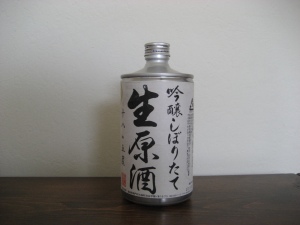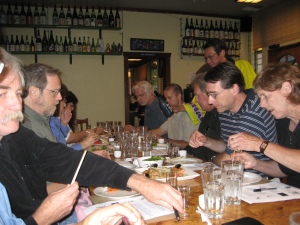
Sake Tasting @ Naomi Sushi in Menlo Park: 6 sakes paired with 6 different dishes
Hosted by Iwa
First Course: Salmon sashimi with Japanese eggplant and minced pork in a spicy garlic & peanut sauce
Sake Pairing: Ozeki “White Rocket” from the Nada/Kobe region

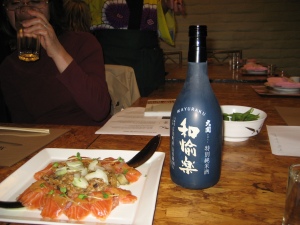
Review/Comments: Overall this was probably my favorite dish of food— the beautiful, buttery raw salmon played with savory spiced meat and eggplant, and the sweet hint of peanuts just made the dish sing. The sake it was paired with was perfectly suited to take on the big flavors in this dish.
The sake alone was dry and slightly astringent. The nose was floral, yet the taste was not. At this point it was only like a 65, however once paired with this dish, the sake became fuller, rounder, softer, and sweeter. This pairing was an amazing example of how effective food can be when tasting sake. Score of the sake jumped to a 75 when paired with food.
Second course: Spicy shrimp rolls in deep fried rice paper over a bed of lettuce with diced raw onion, tomato, and jalapeño
Sake Pairing: Ban Ryu “Ten Thousand Ways”
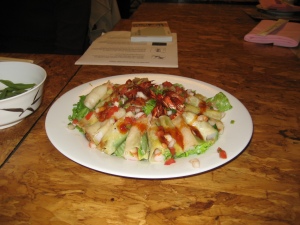

Review/Comments: The name of the sake “Ten Thousand Ways” is in reference to how you can enjoy sake. It is from the Yamagata region near Mt Fuji and the brewery was established back in 1778!
The color is a slight hint of yellow and the nose has light floral notes; the flavor, however is much deeper. There is a dense, big flavor that is somewhat sweet–notes of dried or candied fruits, apricots, flowers, and just plain sugar. The taste becomes bigger, fuller, rounder, and there is a long substantial aftertaste. Overall score of 80.
The shrimp have been dressed in a wonderfully sweet and spicy chili sauce, and avocado is discovered in the role– the smooth buttery texture of the avocado was a bit disconcerting when expecting the crunch of a nicely cooked shrimp–but after I realized what I was getting, it was quite delicious. The bed of lettuce was covered in oil and salt and other tightly diced veggies and tasted great, offering a spicy and savory balance to the sweeter sake.
Third Course: Clam risotto
Sake Pairing: Wataribune Junmai Ginjo
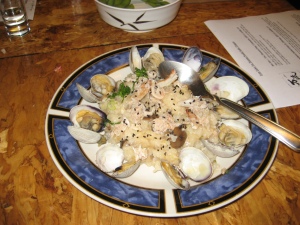
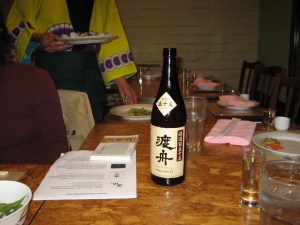
Comments/Review: Wataribune is the name of the sake rice that is used to make this sake. This particular rice had fallen out of use for over 50 years before this brewery revived it. The color is mostly clear but with a hint of yellow (or maybe it is the reflection of the wooden table?!); the nose is a bit musty, musky, earthy– like straight up fermentation. I am expecting an equally earthy flavor, perhaps something nutty.. but instead am surprised to taste something that is rather delicate, smooth, and quite decadent; hints of ripe cantaloupe and honeydew shine through. There is also is a bitter flavor I can sense– like a gin martini with an extra dash of vermouth. Score: 76. I just was not a fan of this nose nor did I love the overall flavor, in addition, I did not care for this pairing overall, which definitely affected my score. I would understand if a person gave this a 90 and would also understand a 70–it is one of those marginalizing love it/hate it sakes.
As for the food, unfortunately I have had a few bad risotto experiences in my life, and can only handle its richness in small portions (ie I would have a taste of someone else’s, but would never order it myself). This particular risotto, was super-rich and creamy and there was definitely an abundant clam flavor that I was not a fan of. Overall this was my least favorite dish and pairing of the evening.
Fourth Course: Here is where things begin getting a little hazy.. so much sake and food… Here we have some hamachi (yellow tail) and ahi (tuna) sashimi,
Sake Pairing: Kasumi Tsuru Yamahai Ginjo!


Comments/Review: The rather generously sliced fish were garnished with mangoes, baby watercress, cucumber, blk pepper and a slightly spicy sauce. Rich and buttery, this dish is a winner and sure to bring out the best in any sake–and boy did it ever.
This Yamahai sake is from Hyogo, an area famous for their crab and seafood, and so I expect that this yamahai will be made to go with this clean yet rich sashimi dish, although yamahais are known for their nuttier, earthier flavors.
The nose is already surprising–Yamahai sake is sake that is made with the naturally occurring yeast in the brewery, which typically offers it an earthy musky scent–but this nose is actually light and fruity, with hints of apple and pear. The taste is more complex, but still in the area of melons.
Overall the sake was round and floral and fruity, but with the added complexities earned through the yamahai brewing technique– you could taste the underlying richness from the natural yeast. A neighbor next to me remarked that this sake was “the salt of the earth”. I couldn’t agree more. Score: 89.
Fifth Course: Chirashi (mixed sashimi over rice) !
Sake Pairing: Eiko Fuji Namazake Junmai Ginjo, Yamagata, SMV +3, Acidity 1.2
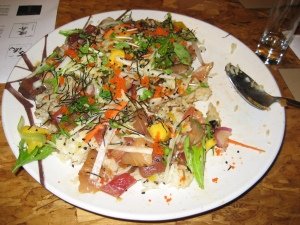
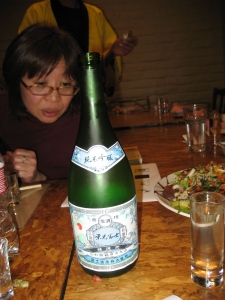
Comments/Review: The Chirashi was fantastic–salmon, tuna, yellow tail, clam, everything except the rice cooker. Really, who knows? By this point I was two sheets to the wind. There was perfectly moist and fluffy rice and some black sesames and raw veggies–avocado, onion, radish, maybe jicama? mango, ginger, mint? wow.
This was different and much lighter than the namas (unpasteurized sakes) that I am used to. Again, I was expecting a heavy-hitter with grass and earth tones, but instead was pleasantly surprised by the candied, buttery flavor. The nose was sweet and the taste was rich and creamy. It had the perfect blend of nuttiness and fruit; a wonderful sake the easily drank like chardonnay. Score– I am going to guess 90, but honestly I forgot to write it down… so much sake 🙂
Sixth Course: Amazingly cooked sirloin with mushrooms and peppers
Sake Pairing: Kuromatsu Hakushika “Black Pine, White Deer” Junmai Daiginjo

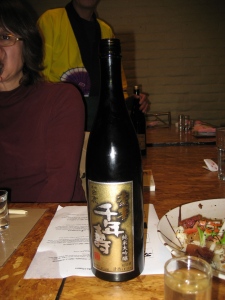

Comments: Whoops. Clearly I forgot to take the picture in time… oy, so much sake! Alright, here we have a beautifully cooked medium rare steak that is tender and juicy, and so wonderfully covered in a mushroom and black pepper sauce. Definitely a winner of a dish, but can this sake match the bold flavor of the steak?
Yes. This is not a dainty daiginjo– big bold flavors give this sake a strong full body that can and does pair with meat. The sake is a gold medal winner, for 2 consecutive years now. It has been aged slightly in both the barrel and the bottle, giving it a mature, strong, well rounded flavor. My notes read “one big hot sake”! Yes it was. Score: 92.. I think. I drink a second serving.. maybe it is a 94? I lose count…. a helluva night.
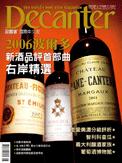 by Natasha Hughes
by Natasha Hughes


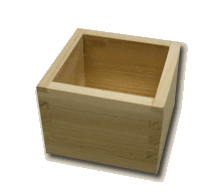
















 Well buckle down the hatches as the “second flight” of seasonal nama zakes have blessed True Sake. This is the same second flight as last year and has some great brews to choose from. For those of you looking for a more dry and clean nama experience jump on the Otokoyama. If it smoothness personified then look no further than the Dewanoyuki. If you like it rich and raw with layers of complexity seek out the Gokyo. And for those seeking the massive nama experience with tons of attitude and explosive flavor reach for the Kaika. All in all this flight is drinking equally as well as last year and a couple of the brews have changed for the better.
Well buckle down the hatches as the “second flight” of seasonal nama zakes have blessed True Sake. This is the same second flight as last year and has some great brews to choose from. For those of you looking for a more dry and clean nama experience jump on the Otokoyama. If it smoothness personified then look no further than the Dewanoyuki. If you like it rich and raw with layers of complexity seek out the Gokyo. And for those seeking the massive nama experience with tons of attitude and explosive flavor reach for the Kaika. All in all this flight is drinking equally as well as last year and a couple of the brews have changed for the better.




